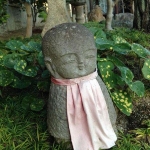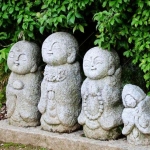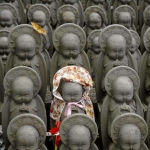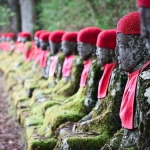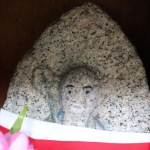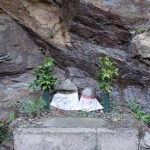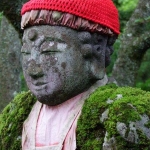O-Jizo-sama
“O-Jizo-sama is basically like a mother to us.
We ask for help or implore it, as we would a mother.
Because of all the deities, it is the one we feel closest to.”
As Jizo, the bodhisattva (bosatsuin in Japanese) has become the most beloved figures of Japanese Buddhism. Stone figures of Jizo populate temple grounds, city and country.
O-Jizo-Sama, as he is often respectfully called, is one of the most venerated Bosatsu in all of Japan. He is usually portrayed as a monk, wearing robes with a shaven head. He often holds a staff called a shakujo. This is used to both scare away living creatures so he doesn’t hurt them accidentally, and to awaken us from our dream-like world of illusion. On images and statues, he holds a wish-granting jewel that he shares with Kanzeon Bosatsu and Vishnu in the Hindu tradition.
Women also pray to Jizo for fertility and easy childbirth. Some temples sell amulets for this purpose.
Jizo’s role in Japan has changed along with the needs of modern society with the introduction in the 1970s of mizuko kuyo, a ceremony for aborted fetuses performed at local temples.
Dressing Jizo, accruing merit: Jizo statues are often dressed with a small red bib around their necks. This practice of dressing Jizo includes hats, robes, or anything one wishes to adorn his figure with. Such red bibs were said to have been worn by children in earlier times. Although the bibs are usually red, a color that represents safety and protection, they can be any color, fabric or pattern.
Local women usually take care of Jizo statues and provide them with hand-knitted hats and hand-sewn bibs. The practice of dressing Jizo statues may be related to accruing merit for the afterlife, a common theme in Buddhism. Jizo represents a monk, and when people dress a monk statue, they accrue merit. Dressing Jizo gives people a chance to interact with him.
Sentai Jizo (one thousand Jizos): Jizo is also the overseer of muen botoke (the unconnected dead), those forgotten graves of ancestors or of the marginally departed. In medieval times noh and kyogen theater in Nara and Kyoto were performed near graveyards to appease the restless souls of the dead. Sometimes you will see stacks of abandoned tombstones, those no longer attached to a grave, gathered together and tied individually with red bibs. This practice is intimately linked to Jizo as the guardian of lost souls. Large groupings of Jizo statues are known as sentai jizo (one thousand Jizos). When grouped together at muen botoke sites, these stones embody the prayers and emotions of family members who once prayed for the deceased—they become “living icons” with the power to save other beings on earth.
Like most of the transcendent bodhisattvas, Jizo may appear in many forms and is ready to help whenever and he is needed. Nearly every community in Japan has its own beloved Jizo statue, and each one has its own name and characteristics. For example, Agonashi Jizo heals toothaches. Doroashi Jizo helps rice farmers with their crops. The Miso Jizo is a patron of scholars. The Koyasu Jizo assists women in labor. There is even a Shogun Jizo, in armor, who protects soldiers in battle. There are easily a hundred or more “special” Jizos throughout Japan.
The Mizuko Ceremony
The Mizuko Ceremony, or Mizuko Kuyo, is a ceremony that centers on Mizuko Jizo. Mizuko means “water baby,” and primarily is performed on behalf of a miscarried or aborted fetus, or a stillborn or very young infant. The Mizuko dates to the post-World War II period in Japan, when abortion rates rose significantly, although it has some more forerunners.
As part of the ceremony, a stone Jizo statue is dressed in children’s clothing — usually red, a color thought to ward — and placed on the temple grounds, or in a park outside the temple. Such parks often resemble a and may even swings and other playground equipment. It’s not unusual for living children to play in the park while parents dress their Jizo in new, seasonal clothes.


